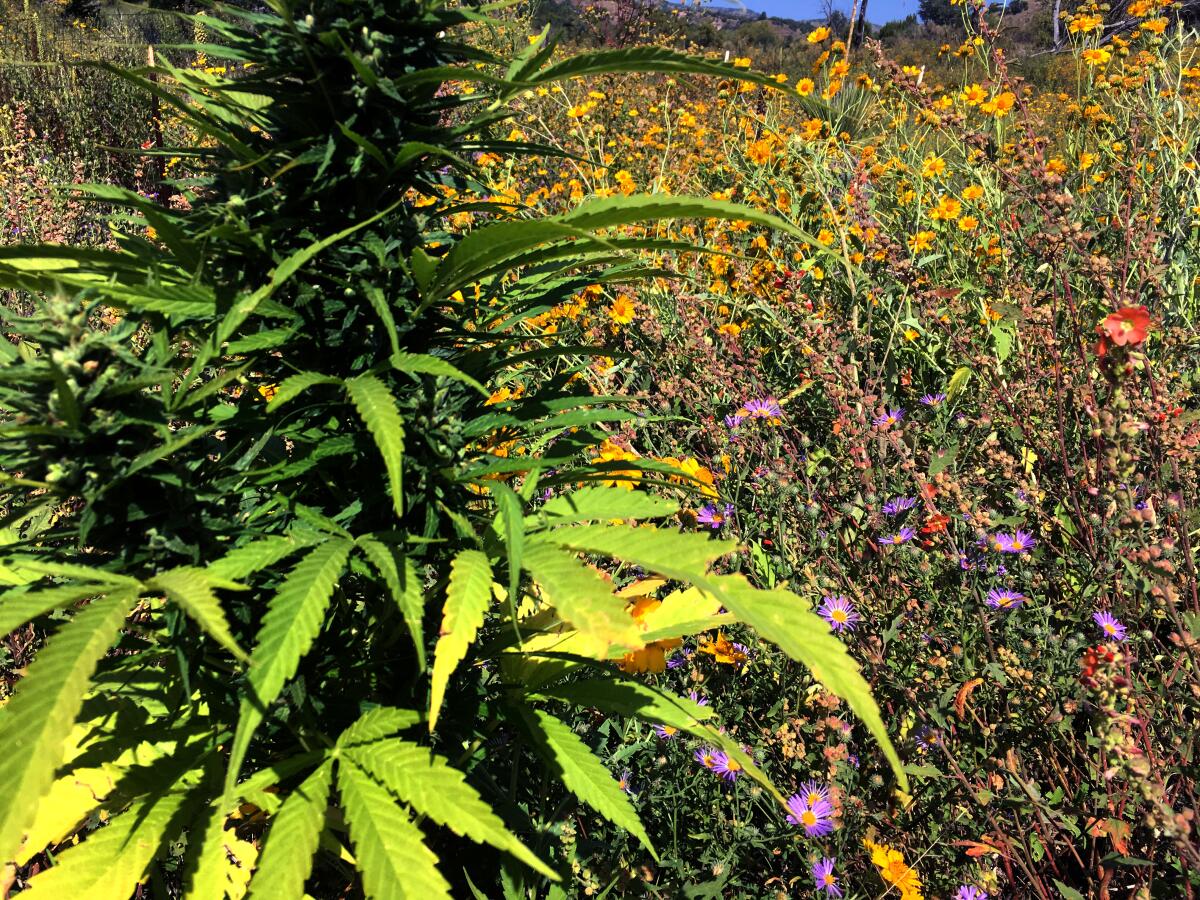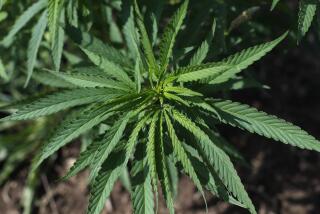Op-Ed: Hemp is legal again. Congress should make it easier to farm

- Share via
Climate change got personal for my family in 2013, when a refugee bear fleeing a nearby wildfire scaled my goat-corral fence and killed most of the herd in front of our eyes. Milk providers, yoga partners and friends Natalie Merchant, Bette Midler and Stevie Nicks were lost that day (we name our goats after singers we like). Baby Taylor Swift survived and slept inside with my human kids for a while.
Since that day, I’ve been consciously sequestering carbon — trying to reduce carbon miles by eating and buying locally, avoiding petroleum-based plastics in favor of compostable materials and furthering both of these goals by planting hemp and milking goats. It’s my day job: farming so my grandkids have a habitable planet.
And it’s not just me. America’s 21,496 hemp farmers are buying humanity some time by growing a superfood, wellness and fiber crop whose roots not incidentally help sequester a lot of carbon. I plant a small field of it — experimenting with various cultivars, providing some to other farmers and researchers, eating some — at our Funky Butte Ranch in New Mexico. On a larger scale, I’m part of a team assisting a Rosebud Sioux tribal enterprise growing 125 acres of organic hemp.
More hemp acreage is better for all of us.
In 2018, Congress restored hemp, a low-THC member of the cannabis family, to full legality after 80 years of classification as a controlled substance. (THC is the psychoactive component of cannabis.) In the three years since relegalization, the commercial crop crossed the billion-dollar valuation mark.
Two reasons we ought to celebrate this milestone: A lucrative crop builds struggling farming economies. And hemp is a regenerative agriculture star.
As a cash crop or a cover crop, hemp’s substantial taproots are absolutely stunning at creating the conditions that build soil’s carbon capture qualities. And cover crops, in rotation with traditional crops, can sequester an average of 425 to 1,584 pounds of atmospheric carbon per acre per year, according to a University of South Carolina study.
Along the way, hemp cleans soils of toxins. I’m proud to report that New Mexico State University researchers are seeing success in uranium uptake from contaminated mining soil planted with a hemp variety that I’ve been developing for five seasons.
Besides your patronage, those of us who farm hemp ask one thing: Please loudly help us change the federal guideline for how much THC is allowable in commercial hemp.
Don’t know your Delta-8 from your THCv? We strain the alphabet soup for you.
The 2018 relegalization law set hemp’s limit at 0.3% THC. (Psychoactive cannabis typically contains at least 15% and usually more.) For a lot of reasons, including local soil conditions, between 20% and 30% of the hemp crop has been testing mildly “hot” — above the 0.3% level. Nearly all the tests come in somewhere south of the still very low level of 1% THC, but any hot result means the crop can be destroyed, along with the farmer’s revenue.
The 0.3% level is arbitrary as well as unworkable. Most parts of a hemp plant’s valuable architecture — the seed, fiber and roots — contain no THC at all. The flowers register THC, but upping the limit for hemp to 1% won’t make it psychoactive. No one is smoking 1% flower to get high.
From a policy perspective, hemp is about the last crop a wise society would restrict in any way. Before it got outlawed in the 1930s, it was cultivated as an essential crop all the way back to the founders. George Washington grew hemp at Mount Vernon. When George H.W. Bush had to escape his burning bomber in World War II, the cord he pulled to open the parachute was made of hemp.
Commercial hemp fiber is made into textiles, ink, paper, construction materials and biodegradable plastics. The flowers go into sleep aids and pain relievers, low in THC but high in cannabinoids such as CBD or CBG. Hemp seeds can be eaten whole or de-hulled, or they can be crushed into oil. My goats love the hemp meal byproduct of oil pressing.
I eat the seeds every day in yogurt and shakes — they’re a balanced source of all three Omega fatty acids, high in protein, packed with minerals. Early results from a study, led by Qing X. Li of the University of Hawaii, indicate that a diet rich in hemp seeds might even help inhibit the expansion of lipid cells in humans. In other words, hemp could help reverse the obesity epidemic.
Right now, we’re at about 500,000 acres licensed for hemp growing nationwide. Compare that with 89 million acres of corn, though. There’s lots of room for growth, especially if we make hemp as risk-free for farmers as other crops.
Other nations, including Switzerland, Ecuador and Thailand, have adopted the 1% “definition” of hemp. Two major farm advocacy groups, the National Farmer’s Union and the Farm Bureau, are in favor of the change in the U.S. And you can help the effort by signing the online petition at the Vote Hemp website (Vote Hemp is an advocacy group). A call to your representative and senators couldn’t hurt either.
In the meantime, when you buy hemp seed, fiber or flower products, please support local farmer-owned enterprises, especially organic ones. You’ll be investing in sustainable rural communities and sustainable agriculture, while helping mitigate climate change.
I’m just in from my own hemp field, my fingers dirty with carbon-sequestering soil. Pollinators were dive-bombing me as I checked on the crop. Let me tell you, in a multitasking life, dodging butterflies in a fragrant hemp field is about the most fun you can have making a living.
And there’s another payoff: With the seeds forming on the Funky Butte Ranch hemp crop, I like the feeling of knowing that no matter what happens, my human kids and my goat kids will both eat high-protein superfood this winter.
Doug Fine is the author of six books, including “American Hemp Farmer: Adventures and Misadventures in the Cannabis Trade.”
More to Read
A cure for the common opinion
Get thought-provoking perspectives with our weekly newsletter.
You may occasionally receive promotional content from the Los Angeles Times.











